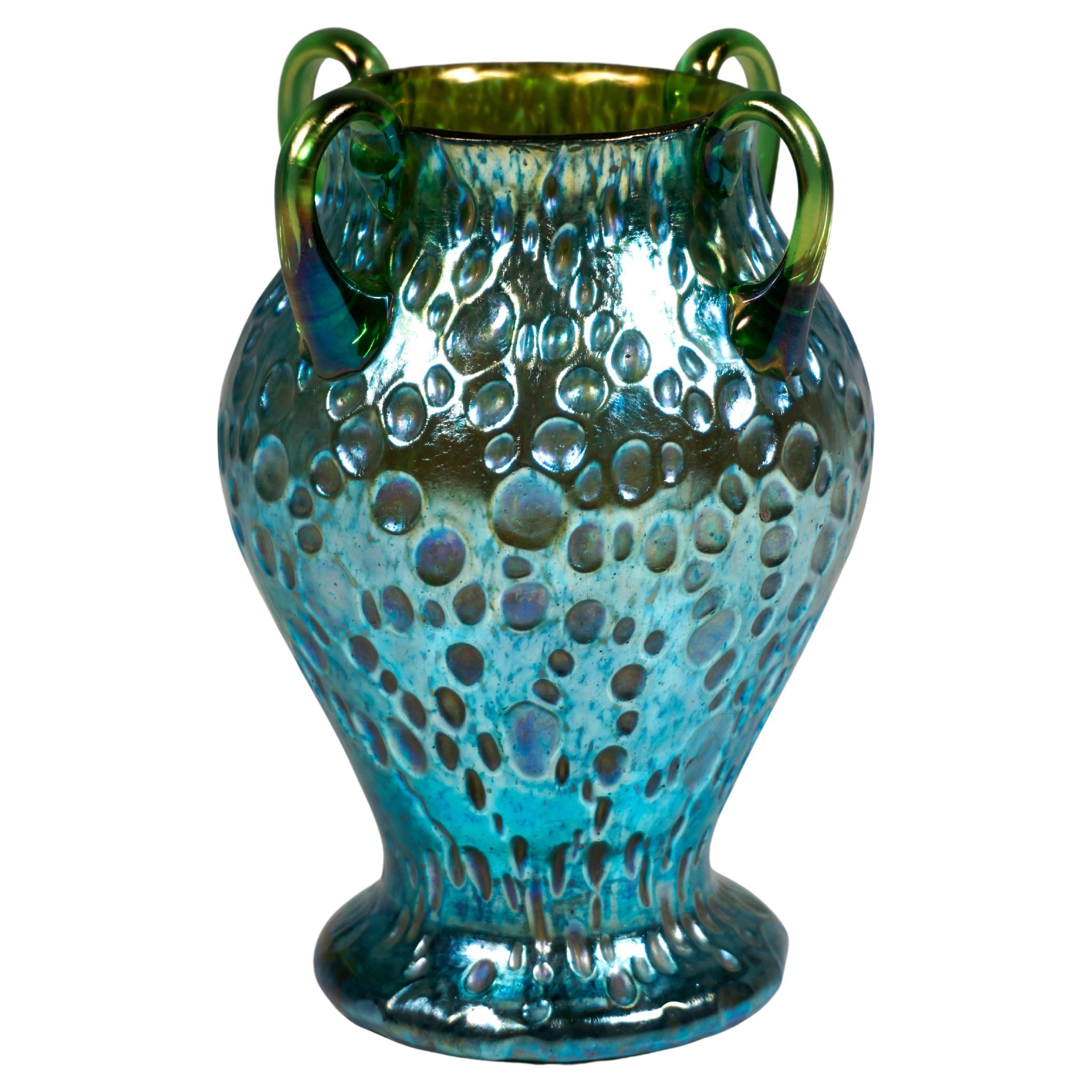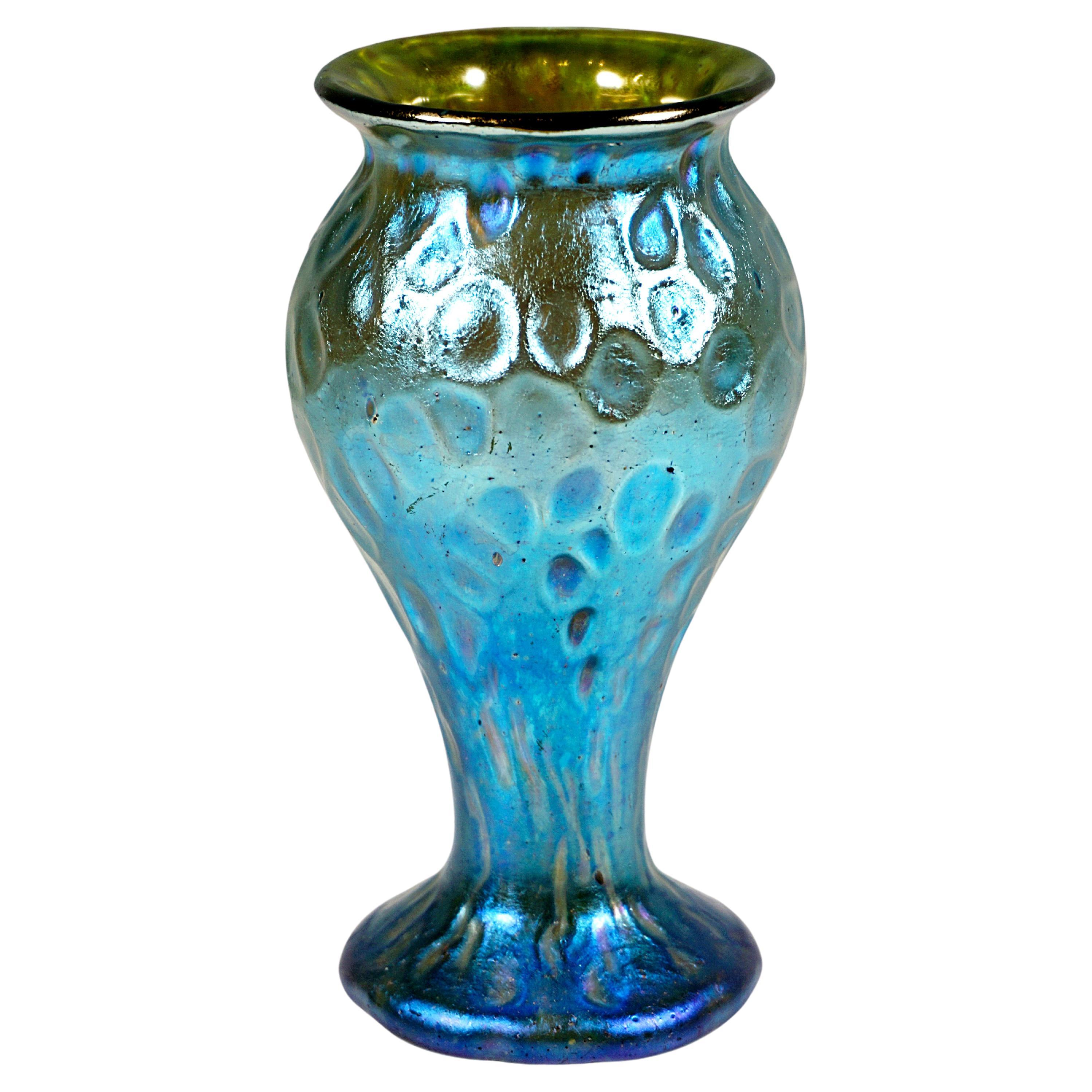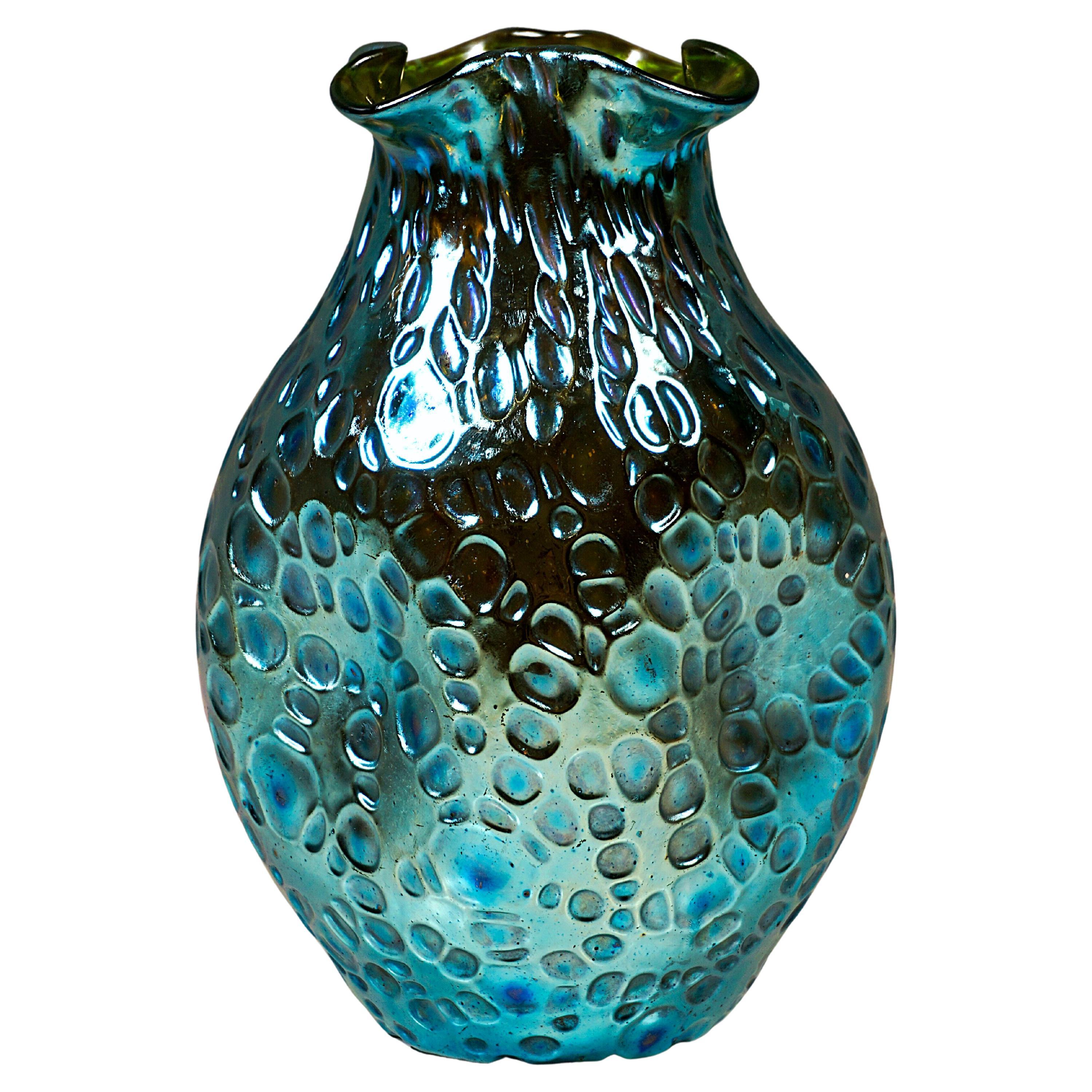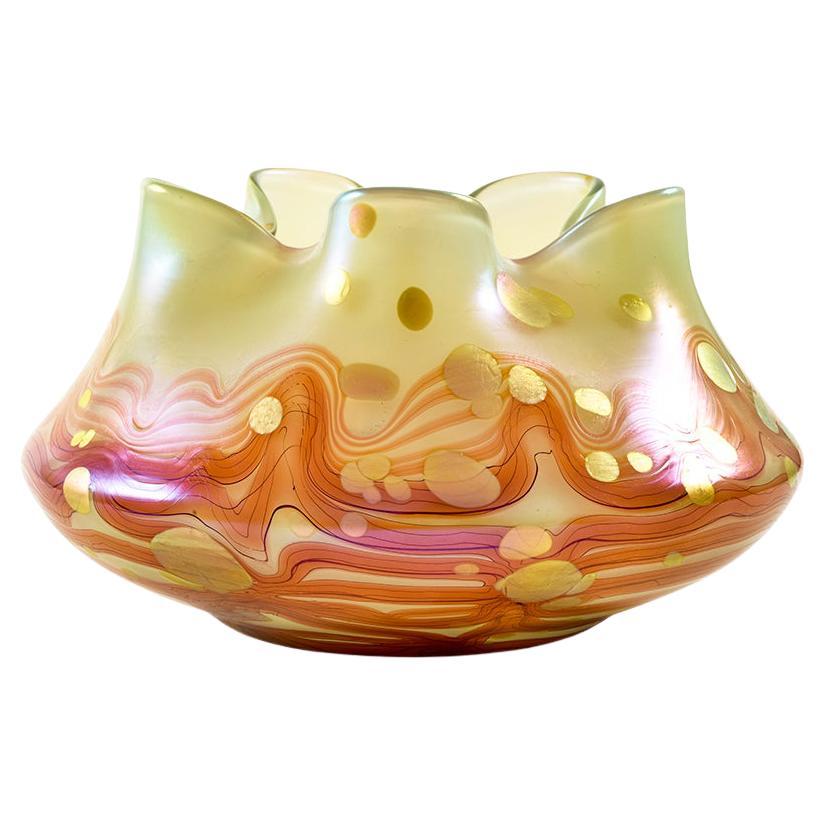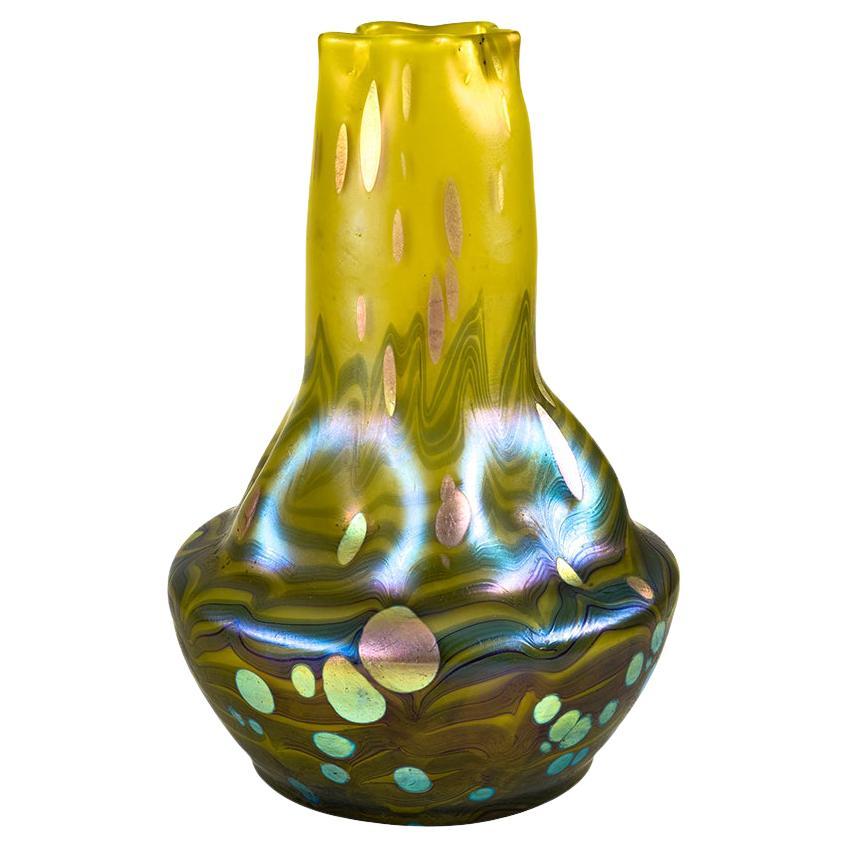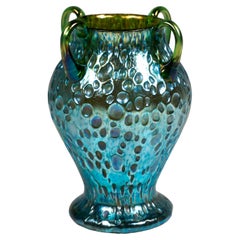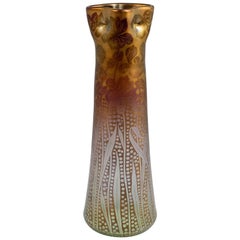
Rare Gold Etched Loetz Vase with Iris Flowers, circa 1902
View Similar Items
1 of 5
Rare Gold Etched Loetz Vase with Iris Flowers, circa 1902
About the Item
- Creator:Loetz Glass (Maker)
- Dimensions:Height: 11.03 in (28 cm)Diameter: 3.75 in (9.5 cm)
- Style:Art Nouveau (Of the Period)
- Materials and Techniques:
- Place of Origin:
- Period:1900-1909
- Date of Manufacture:1902
- Condition:Wear consistent with age and use.
- Seller Location:Vienna, AT
- Reference Number:1stDibs: LU981513661402
You May Also Like
- Loetz Art Nouveau Vase Crete Diaspora Silver Iris, Austria-Hungary, Around 1902By Loetz GlassLocated in Vienna, ATIn the model with irregular spherical decor blown body in baluster shape, round stand, bulging upwards after constriction, slight narrowing, straight cut mouth rim, four applied small handles, polished pontil. Shape: Production number / pattern not preserved Decor: Crete Diaspora Silver Iris - Green glass with silver...Category
Antique Early 1900s Austrian Art Nouveau Glass
MaterialsGlass
- Loetz Art Nouveau Vase, Crete Diaspora Silver Iris, Austria-Hungary, Around 1902By Loetz GlassLocated in Vienna, ATIn a model with irregular spherical decor blown body in baluster shape, round offset base, bulging upwards, after a slight constriction flared mouthrim, polished pontil on the bottom. Shape: Production number / pattern not preserved Decor: Crete Diaspora Silver Iris Green glass with silver...Category
Antique Early 1900s Austrian Art Nouveau Glass
MaterialsGlass
- Loetz Art Nouveau Vase Crete Diaspora Silver Iris, Austria-Hungary, Around 1902By Loetz GlassLocated in Vienna, ATIn the model with irregular spherical decor blown body in baluster shape, round stand, bulbous widening upwards with four times indented wall, slight constriction, flared mouth rim pressed into quatrefoil, polished pontil. Shape: Production number / pattern not preserved Decor: Crete Diaspora Silver Iris Green glass with silver...Category
Antique Early 1900s Austrian Art Nouveau Glass
MaterialsGlass
- Loetz Rubin Matte Iris Handles Ewer Vase, Rare 1898By Loetz GlassLocated in Dallas, TXLoetz Rubin Matte Iris - 1898 (aka: rubin metall) Registered Model: PM I-7875 Ruby ground; metallic-bronze iridescent finish (iris) with purple highlights. Measures: Height 7.75 inches Width 4.25 inches Condition: Excellent AVANTIQUES is dedicated to providing an exclusive curated collection of Fine Arts, Paintings, Bronzes, Asian treasures, Art Glass and Antiques. Our inventory represents time-tested investment quality items with everlasting decorative beauty. We look forward to your business and appreciate any reasonable offers. All of our curated items are vetted and guaranteed authentic and as described. Avantiques only deals in original antiques and never reproductions. We stand behind our treasures with a full money back return if the items are not as described. In 1836, Johann Eisner established a glassworks in the Southern Bohemian town of Klostermühle, today part of the Czech Republic and called Klášterský Mlýn. His heirs sold the glassworks to Martin Schmid in 1849, and two years later Schmid sold it to Frank Gerstner, attorney-at-law, and his wife Susanne. Susanne was the widow (‘Witwe’ in German) of Johann Loetz, a glassmaker about whom we know very little. Gerstner transferred sole ownership to Susanne shortly before his death in 1855, and she successfully led and expanded the company during the subsequent 20 years, manufacturing mainly crystal, overlay and painted glass. In 1879, Susanne transferred the company – now called ‘Johann Loetz Witwe’ – to Maximilian von Spaun, the son of her daughter Karoline. One year later, von Spaun hired Eduard Prochaska and the two of them modernized the factory and introduced new, patented techniques and processes. The Historicist Period The first fruits of this collaboration were exciting innovations in Historicism glass, including Intarsia and Octopus glass and the very popular marbled (‘marmorisierte’) glass which imitated semi-precious stones like red chalcedony, onyx and malachite. Success at exhibitions in Brussels, Munich and Vienna were crowned by awards at the Paris World’s Exposition in 1889. In 1897, von Spaun first saw Tiffany Favrile glass exhibited in Bohemia and Vienna, and this convinced him that the art nouveau style was also the way to go for Loetz Witwe. The next eight years were to be the most artistically significant and profitable period in the entire history of the company. The Art Nouveau Period – the Glory Years Loetz Paris-Expo1900Loetz Paris-Expo1900The glassworks created large numbers of its own new designs of iridescent, trailing art nouveau glass, sometimes in collaboration with well-known artists and designers like Marie Kirschner and Franz Hofstötter (aka Franz Hofstätter). The zenith of Loetz art nouveau glass was epitomized by the so-called Phänomen series of designs, much of it designed by Hofstötter, which won a Grand Prix (alongside Tiffany, Gallé, Daum and Lobmeyr) at the Paris World’s Exposition in 1900. The company’s success during this period had two prime drivers – the technical expertise of Prochaska and the business acumen of von Spaun. Loetz Witwe created many of its own designs, and also supplied glass commissioned by major customers like E. Bakolowits (Vienna) and Max Emanuel...Category
Antique 1890s Czech Art Nouveau Vases
MaterialsArt Glass
- Glass Vase Loetz Cytisus Decoration Blue Orange Gold, circa 1902, Art NouveauBy Loetz GlassLocated in Klosterneuburg, ATAustrian Jugendstil glass vase Johann Loetz Witwe blue orange gold circa 1902 "Cytisus Neuroth" decoration Art Nouveau Bohemian Glass The "Cytisus" decoration is certainly one of ...Category
Antique Early 1900s Austrian Jugendstil Vases
MaterialsGlass
- Austrian Jugendstil Glass Vase Argus Decoration circa 1902 Johann Loetz WitweBy Loetz GlassLocated in Klosterneuburg, ATAustrian Jugendstil Glass Vase Johann Loetz Witwe with Argus decoration PG 2/351 ca. 1902 The “Argus” decoration is one of the most popular varia...Category
Antique Early 1900s Austrian Jugendstil Vases
MaterialsGlass, Blown Glass
